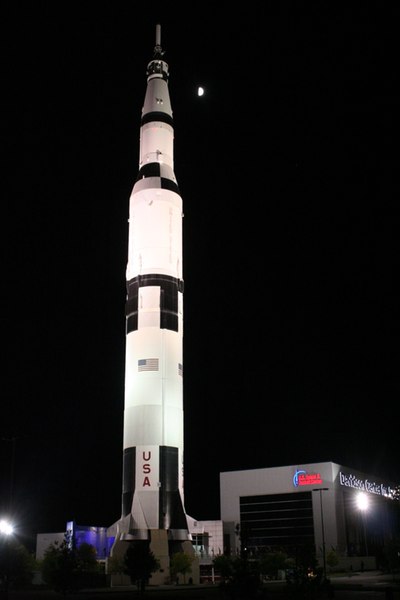A mighty roarby Dwayne A. Day
|
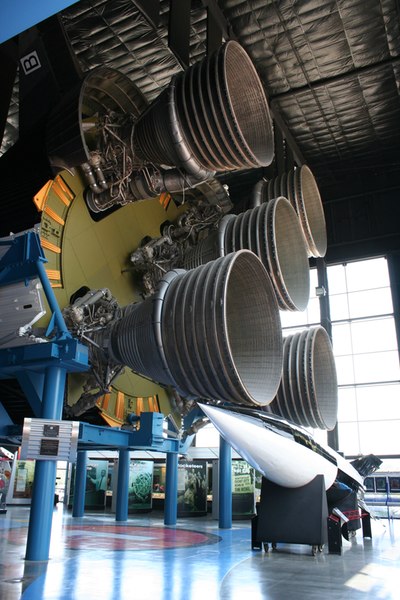 (credit: D. Day) |
The original museum building is still tired (more on that in a moment), but walking into the Davidson Center a little over a week ago I was surprised and impressed, very impressed. The cracks in the floor were still there, but I did not see, and wasn’t looking for, more evidence of construction problems; maybe the roof leaks and I just don’t know it. But the center itself is great. The museum has done an excellent job of telling a story and educating the public, and not dumbing everything down to the lowest common denominator. Huntsville, of course, is the home of NASA’s Marshall Space Flight Center, which designed and tested much of the Saturn V, and the Davidson Center focuses on that aspect of the Apollo program. The center includes an Apollo Command Module and a mockup Lunar Module. But most of the displays in the cavernous hall are devoted to the rocket’s engines and their testing, as well as the Instrument Control Unit that guided the rocket in flight, in other words all the work that was performed just a few kilometers away at Marshall.
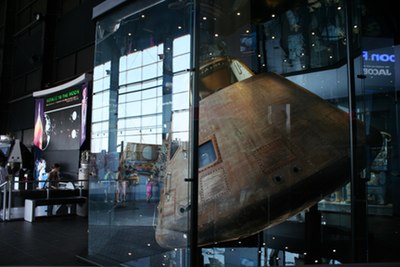 (credit: D. Day) |
Museums can no longer simply put objects in display cases with wordy labels to explain them. Modern museums include interactive elements and video and audio presentations. But some museums miss the mark, adding buttons to press and levers to shift simply to give over-excited youngsters something to play with. The Davidson Center exhibits strike a proper tone, with interesting graphics and labels, as well as a few levers to pull and buttons to press. They are also all new. Despite a few references to the now-canceled Constellation program, the displays are not 30-year-old cabinets simply dragged over from the aging museum next door, and haven’t faded in the sun coming in the building’s giant window wall.
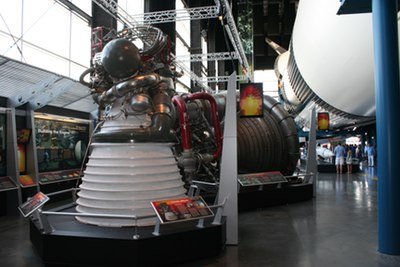 (credit: D. Day) |
The curators have included some nifty footnotes from the development of the rocket, including very small as well as large wind tunnel models, one of the camera pods used to monitor engine performance and then jettisoned to parachute back to Earth, and exhibits explaining key challenges to the Saturn’s development, such as vehicle oscillation and rocket engine combustion instability. There is an exhibit that simulates the test stand at Marshall used for firing all five of the Saturn’s main engines simultaneously: visitors can stand underneath it and get exposed to a small fraction of the light and roar of such tests (a better simulation of the heat can be experienced in the Alabama sun out in the museum parking lot). There is a giant swing arm and associated white room that the astronauts used to access the Apollo capsule. There are also displays on the history of rocket development, a V-2 rocket dwarfed by the Saturn’s F-1 engines, and procedure trainers for the Mercury and Gemini spacecraft.
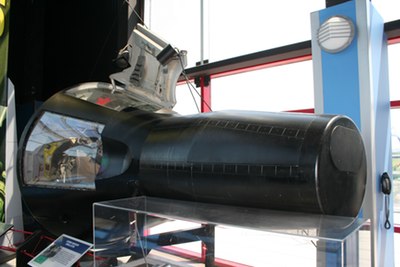 (credit: D. Day) |
I’m not easily impressed by much anymore, but this was an excellent museum display.
Unfortunately, the same cannot be said for the Space and Rocket Center’s original building. Most of the space displays have been removed from the building, but it still presents an ugly façade, and it is clearly worn out. The men’s restroom near the front entrance looked like it contains original 1970s-era plumbing, and the building lobby is very poorly designed. The first exhibit hall upon entering the museum appears to be made up of leftover displays from other exhibits.
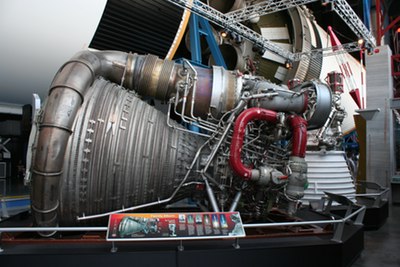 (credit: D. Day) |
The building also suffers from a misguided effort to spin history, with a giant banner hanging over the main exhibit hall labeled “A Moral Decision.” Apparently this refers to Wernher von Braun’s decision to surrender to the United States rather than Soviet forces at the end of World War II. This was hardly a moral decision: von Braun figured he would be treated better by the West than the Russians, and the Americans, unlike the Brits, could afford his rocket research. The political spin is also rather bold considering that von Braun had been working for Hitler and used slave labor to construct his V-2s. The truth cannot be denied, and certainly shouldn’t be twisted into a pretzel. I’m personally glad that von Braun chose to come to the United States, helping us not only to thwart the Soviet Union but also to put Americans on the Moon, one of the singular achievements of mankind. But we should not delude ourselves about what happened.
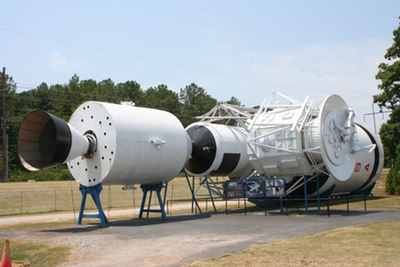 (credit: D. Day) |
The main building is otherwise a bit of a hodgepodge of displays and attractions. A substantial part of the building is devoted to supporting Space Camp and its various iterations. There is also a display devoted to the US Army, although much of it has to do with robotics and UAVs, with a smattering of missiles, which are still a primary focus of the nearby Redstone Arsenal. There was also a rock climbing wall for kids, and motion simulators. The main section of the museum featured a traveling exhibit, “Mammoths and Mastodons.” Museums are déclassé these days, and “science centers” are in, trying to attract school groups. One unfortunate aspect of this trend is that many of the traveling displays tend to be watered-down—not really science, but sciency, with titles like “The Science of Slime” or featuring a movie tie-in that with a short shelf life (i.e. “The Mummy.”) That was not the case for “Mammoths and Mastodons,” which featured some interactive displays, but is also filled with educational information for both adults and the children, who are, after all, the future (blah, blah, blah).
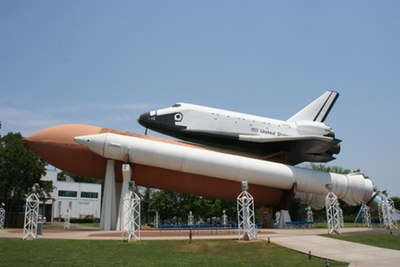 (credit: D. Day) |
One disappointment for the space history lover is the museum’s rocket park, which features a number of great rockets and missiles all badly in need of paint and better protection from the elements. My personal favorite is the Shuttle-Centaur engineering article tucked behind the space shuttle mockup. It is gleaming silver and looks like it is ready to rocket Galileo to Jupiter.
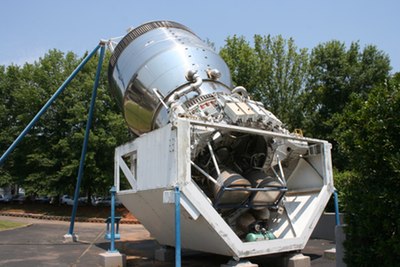 (credit: D. Day) |
With the Davidson Center now filled with exhibits, we can only hope that the museum’s leadership will be able to focus on fixing up the older parts of the complex. Realistically, the old building should probably be replaced, and the exterior artifacts at least given new paint jobs. The ideal solution would be another building like the Davidson Center, capable of housing a number of the larger exterior artifacts. The Davidson Center is such a knockout facility that it will be hard to emulate, and, of course, that will take money. But overall, the museum is an incredible attraction and educational resource. Go see it.
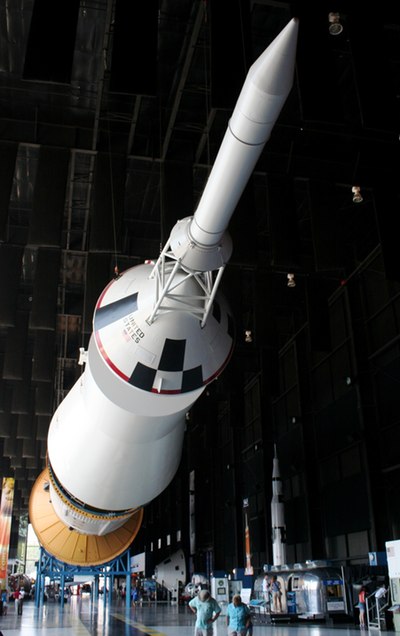 (credit: D. Day) |
